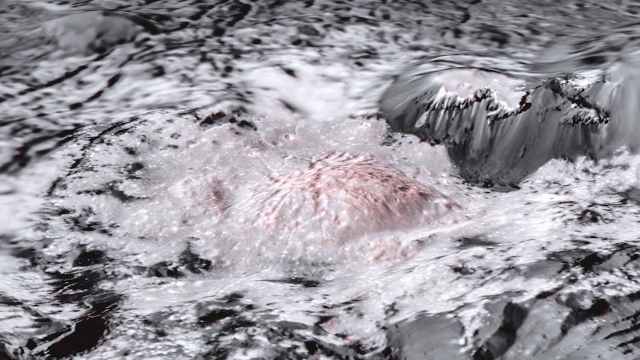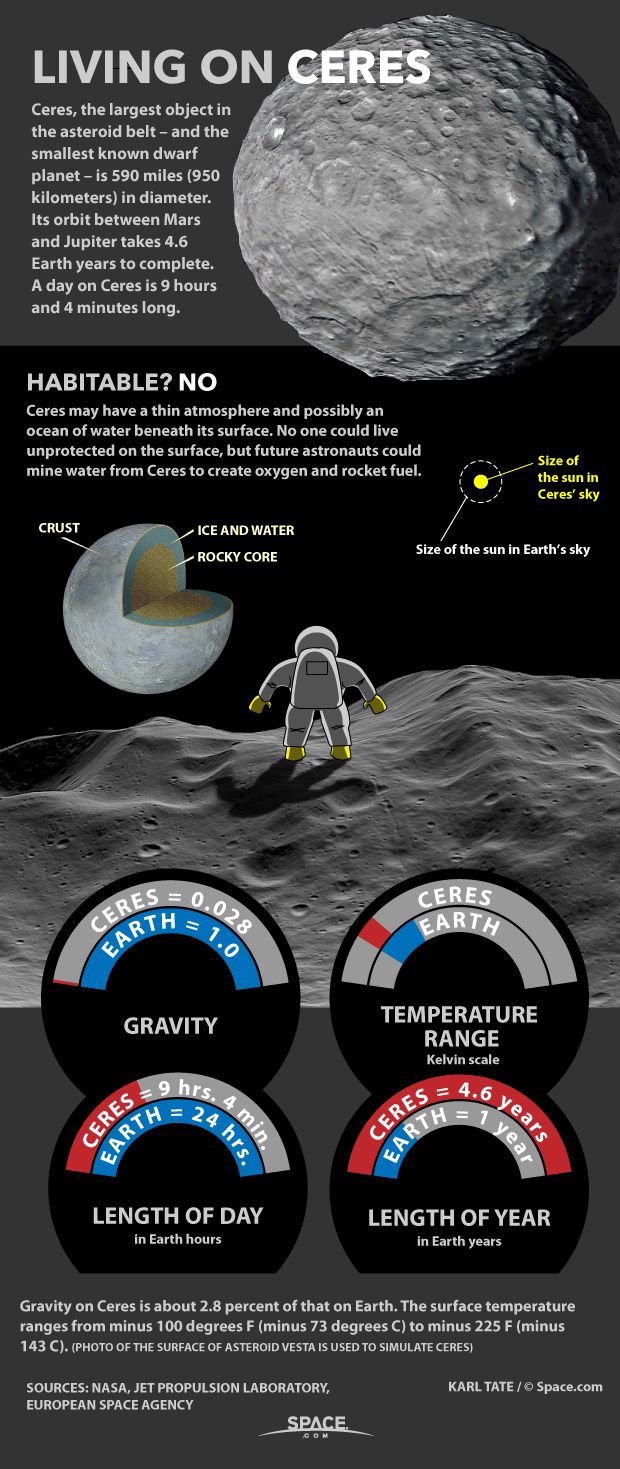Welcome to DU!
The truly grassroots left-of-center political community where regular people, not algorithms, drive the discussions and set the standards.
Join the community:
Create a free account
Support DU (and get rid of ads!):
Become a Star Member
Latest Breaking News
General Discussion
The DU Lounge
All Forums
Issue Forums
Culture Forums
Alliance Forums
Region Forums
Support Forums
Help & Search
Science
Related: About this forumPlanet Ceres is an 'ocean world' with sea water beneath surface, mission finds
The dwarf planet Ceres – long believed to be a barren space rock – is an ocean world with reservoirs of sea water beneath its surface, the results of a major exploration mission showed on Monday.
Ceres is the largest object in the asteroid belt between Mars and Jupiter and has its own gravity, enabling the Nasa Dawn spacecraft to capture high-resolution images of its surface.
...
The team said the salt deposits looked like they had built up within the last 2 million years – the blink of an eye in space time.
This suggests that the brine may still be ascending from the planet’s interior, something De Sanctis said could have profound implications in future studies.
https://www.theguardian.com/science/2020/aug/10/planet-ceres-ocean-world-sea-water-beneath-surface
Ceres is the largest object in the asteroid belt between Mars and Jupiter and has its own gravity, enabling the Nasa Dawn spacecraft to capture high-resolution images of its surface.
...
The team said the salt deposits looked like they had built up within the last 2 million years – the blink of an eye in space time.
This suggests that the brine may still be ascending from the planet’s interior, something De Sanctis said could have profound implications in future studies.
https://www.theguardian.com/science/2020/aug/10/planet-ceres-ocean-world-sea-water-beneath-surface
Mystery Solved: Bright Areas on Ceres Come From Salty Water Below
By analyzing data collected near the end of the mission, Dawn scientists have concluded that the liquid came from a deep reservoir of brine, or salt-enriched water. By studying Ceres' gravity, scientists learned more about the dwarf planet's internal structure and were able to determine that the brine reservoir is about 25 miles (40 kilometers) deep and hundreds of miles wide.
Ceres doesn't benefit from internal heating generated by gravitational interactions with a large planet, as is the case for some of the icy moons of the outer solar system. But the new research, which focuses on Ceres' 57-mile-wide (92-kilometer-wide) Occator Crater - home to the most extensive bright areas - confirms that Ceres is a water-rich world like these other icy bodies.
...
On Ceres' surface, salts bearing water quickly dehydrate, within hundreds of years. But Dawn's measurements show they still have water, so the fluids must have reached the surface very recently. This is evidence both for the presence of liquid below the region of Occator Crater and ongoing transfer of material from the deep interior to the surface.
The scientists found two main pathways that allow liquids to reach the surface. "For the large deposit at Cerealia Facula, the bulk of the salts were supplied from a slushy area just beneath the surface that was melted by the heat of the impact that formed the crater about 20 million years ago," said Dawn Principal Investigator Carol Raymond. "The impact heat subsided after a few million years; however, the impact also created large fractures that could reach the deep, long-lived reservoir, allowing brine to continue percolating to the surface."
https://www.jpl.nasa.gov/news/news.php?feature=7722
By analyzing data collected near the end of the mission, Dawn scientists have concluded that the liquid came from a deep reservoir of brine, or salt-enriched water. By studying Ceres' gravity, scientists learned more about the dwarf planet's internal structure and were able to determine that the brine reservoir is about 25 miles (40 kilometers) deep and hundreds of miles wide.
Ceres doesn't benefit from internal heating generated by gravitational interactions with a large planet, as is the case for some of the icy moons of the outer solar system. But the new research, which focuses on Ceres' 57-mile-wide (92-kilometer-wide) Occator Crater - home to the most extensive bright areas - confirms that Ceres is a water-rich world like these other icy bodies.
...
On Ceres' surface, salts bearing water quickly dehydrate, within hundreds of years. But Dawn's measurements show they still have water, so the fluids must have reached the surface very recently. This is evidence both for the presence of liquid below the region of Occator Crater and ongoing transfer of material from the deep interior to the surface.
The scientists found two main pathways that allow liquids to reach the surface. "For the large deposit at Cerealia Facula, the bulk of the salts were supplied from a slushy area just beneath the surface that was melted by the heat of the impact that formed the crater about 20 million years ago," said Dawn Principal Investigator Carol Raymond. "The impact heat subsided after a few million years; however, the impact also created large fractures that could reach the deep, long-lived reservoir, allowing brine to continue percolating to the surface."
https://www.jpl.nasa.gov/news/news.php?feature=7722
InfoView thread info, including edit history
TrashPut this thread in your Trash Can (My DU » Trash Can)
BookmarkAdd this thread to your Bookmarks (My DU » Bookmarks)
7 replies, 1116 views
ShareGet links to this post and/or share on social media
AlertAlert this post for a rule violation
PowersThere are no powers you can use on this post
EditCannot edit other people's posts
ReplyReply to this post
EditCannot edit other people's posts
Rec (16)
ReplyReply to this post
7 replies
 = new reply since forum marked as read
Highlight:
NoneDon't highlight anything
5 newestHighlight 5 most recent replies
= new reply since forum marked as read
Highlight:
NoneDon't highlight anything
5 newestHighlight 5 most recent replies
Planet Ceres is an 'ocean world' with sea water beneath surface, mission finds (Original Post)
muriel_volestrangler
Aug 2020
OP
NASA spacecraft gets a look at one of the strangest places in the solar system
Judi Lynn
Aug 2020
#6
eppur_se_muova
(36,269 posts)1. "has its own gravity ..." Well, duh!
The Guardian needs to up its game in science journalism.
Try "has sufficient gravity to hold a spacecraft in a stable, useful orbit".
Buckeye_Democrat
(14,855 posts)2. Liquid water... still?
Or is it frozen and liquified from impacts?
Wow! Maybe we don't even need to travel all the way to Europa to seek other life?
cstanleytech
(26,293 posts)3. Most likely yes it still has water in liquid form deep under the ice.
scipan
(2,351 posts)4. Yeah, I wonder where all that heat is coming from.
Maybe the sun, since it's not that far out? Interesting. And I assume it's around 4.5 billion years old so life has had a chance to evolve.
Buckeye_Democrat
(14,855 posts)5. Yeah, the heat for Europa makes sense...
... from the gravitational tidal forces with Jupiter, stretching it constantly like silly-putty.
Ceres seems more mysterious unless it's from regular impacts... and maybe that really explains it? ![]()
Astrophysicists will surely understand it better than me.
Judi Lynn
(160,545 posts)6. NASA spacecraft gets a look at one of the strangest places in the solar system
By Meghan Bartels - Space.com Senior Writer 2 days ago

An animation stitches together images showing briny deposits, colored in reddish, splaying across Occator Crater on Ceres, as seen by NASA's Dawn mission.
(Image: © NASA/JPL-Caltech/UCLA/MPS/DLR/IDA)
For a few months in 2018, as NASA's Dawn spacecraft used up its last drops of fuel, it gave scientists an incredibly detailed look at one of the strangest places in the solar system: Occator Crater.
That's the name of a massive impact site on the dwarf planet Ceres, tucked away in the asteroid belt. In the mission's last months, Dawn flew just 22 miles (35 kilometers) above the dwarf planet's surface and focused its energies on Occator Crater. Earlier observations from the mission had suggested that some sort of geological activity was bringing saltwater to the surface, and scientists wanted a closer look.
Now, initial analysis of those final months of science suggest that Ceres may have been active much more recently than scientists had dared to imagine, according to an article summarizing seven different research papers published Monday (Aug. 10) in the journals Nature Communications, Nature Geoscience and Nature Astronomy.
Ceres: A strange dwarf planet
"Dawn accomplished far more than we hoped when it embarked on its extraordinary extraterrestrial expedition," Mission Director Marc Rayman of NASA's Jet Propulsion Laboratory in California said in a NASA statement. "These exciting new discoveries from the end of its long and productive mission are a wonderful tribute to this remarkable interplanetary explorer."
More:
https://www.livescience.com/dwarf-planet-ceres-giant-crater-nasa-dawn-results.html?utm_source=Selligent&utm_medium=email&utm_campaign=9161&utm_content=LST_Newsletter+&utm_term=3403514&m_i=B6i3xCAutcn9vJAeQOkpI6waguh7pmDhjoQcQjJBIx3RipLdyg%2BqG4s5Ei5jJ_ehkW0jt%2B7NEiblVTrcjSRFJ2p%2Bzq8Hr2CTbrT5yWQBBZ
Baclava
(12,047 posts)7. We got a Space Force now, lets get them out there drilling!
Asteroid mining, that's the ticket off this rock

